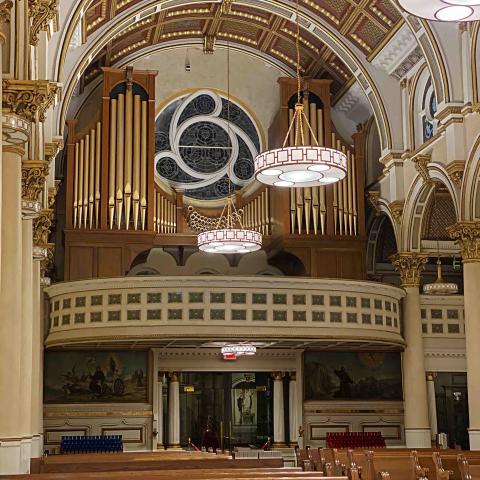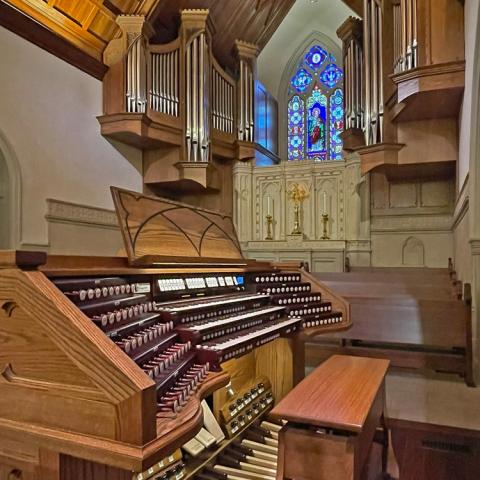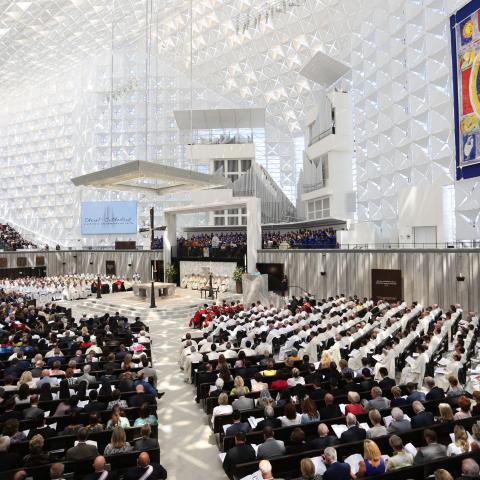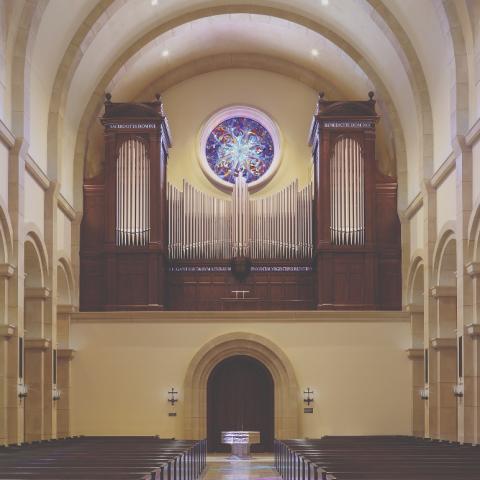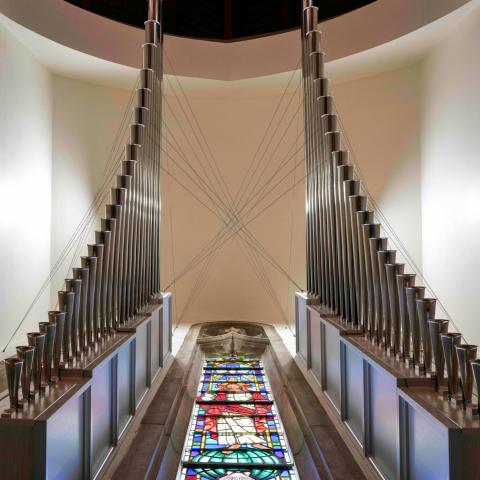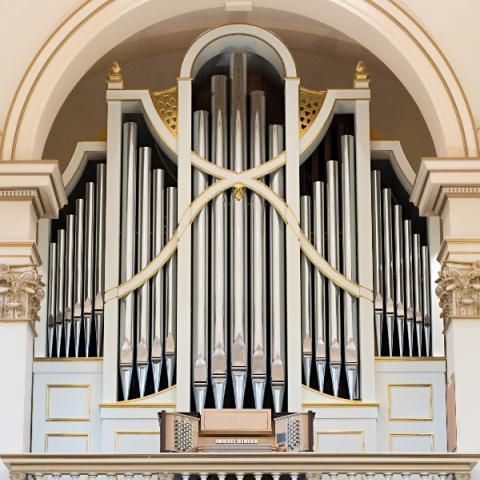Peragallo Pipe Organ Company, Patterson, New Jersey; Saint Malachy Catholic Church, Brownsburg, Indiana

From the builder
When you arrive at a church for the first look and are greeted by the entire staff, you are off to a good start! That was the case with Saint Malachy. Hector Salcedo, the music minister, was joined by the pastor, Father Sean Danda, and the associate pastor, Father Michael Clawson, the business manager, John Kiefer, and the facility manager, Doug Tapscott, and finally the technical wizard, Michael Jasiak, as we walked through the door. This collegial team listened as we discussed everything from acoustics, organ location and casework design, tonal specifications, funding the instrument, and of course—where the best Italian trattoria in the area would be found.
This parish is so welcoming, with a generous gathering space with warm greeters flanked by social areas before entering the nave. You can feel that this place is built and operates well beyond just “Sunday Mass” and provides its parishioners with a full offering of social gatherings. All throughout the installation we were surprised with community events the church would host such as the county fair and hog roast! Approaching the church from the corn fields, one is taken with the free-standing bell tower and the church leaping high into the sky.
This nave is grand, with a seating capacity of over 1,200 and a very unconventional 270-degree in-the-round floor plan. The challenge quickly became how to situate an organ that could cover the full breath of floor space. The acoustical environment was perfectly bright and semi-reverberant, with plenty of height and lots of hard surfaces.
The first order of business was the tonal design. The back and forth with Hector was great—with many late-night conversations. The resulting instrument grew to “cathedral” proportions with a French design controlled from our low-profile terraced four-manual console. The console is movable, as the parish concert series is most active. Within minutes of completion, before the tools were even packed, Hector combined forces with the Diocesan Cathedral Choir and director Andrew Motyka, and accompanied a performance of the Duruflé Requiem as part of a parish Mass.
Frank Peragallo and John Peragallo IV designed a stepped, angled casework to project the tone of the instrument around the church. This proved most effective, and the ceiling’s reflectiveness added to the success of the full tonal coverage. Finally, the addition of a Celestial division, positioned high in the center of the room, offers the organist another tool in accompanying congregational hymnody and moving the solo colors around the room.
The repurposed Reuter pipes were reworked and placed on a new chassis, with the only “new” rank of pipes being the Trompette en Chamade with flared resonator bells. Rather than it being a true commander, it tops the chorus nicely and can be pulled in smoothly for big endings. We left the “party horn” for the Celestial organ where the Walker digitally sampled Tuba Magna offers a powerful yet comfortable alternative to the pipe “chamade.”
The tonal specification provides complete divisions in typical French style. There are three expressive divisions to properly accompany choral singing. A variety of celestes, solo reeds, and percussion are available. The tonal finishing was performed by John Peragallo III with Anthony Peragallo, a fourth-generation organ builder; they were able to successfully blend the repurposed pipework into a true bouquet of sound.
The Solo division, which lives on the fourth clavier, allows the organist to access a variety of stops from various divisions—such as the Great Cornet décomposé, the Positif 8′ Cromorne, and 16′ Clarinette playing at 8′ pitch. The Trompette en Chamade is also available at 16′, 8′, and 4′ pitches non-coupling for easy access. Hector’s skills at improvisation are evident as he employs these stops without concern for the plenum of the other divisions. The Solo is also home to an additional principal chorus of large scale and fiery chorus reeds.
As mentioned, the heavenly Celestial division floats down from on high, offering a nice alternative with a full complement of flutes, strings, reeds, and an additional principal chorus and a tower carillon.
Considerable thought, design, and engineering was put into the planning of this beautiful instrument, so that three important functions of a church organ would be achieved: the leading of worship in song, satisfying the performance requirements of the major musical compositions written for “The King of Instruments,” and finally, enhancing the architectural magnificence of the building. We firmly believe these goals have been fulfilled with the new Peragallo organ at Saint Malachy Church. Since its installation the organ has supported an ambitious concert series and weekly liturgies, taking the music to a new level of inspirational praise.
Many thanks to all at Saint Malachy who assisted in this noble project including Reverend Sean Danda, pastor, Mr. Hector Salcedo, director of music, John Kiefer, business manager, Michael Jasiak, videographer, who documented the entire project; and finally, the talented staff of the Peragallo Organ Company.
—John Peragallo III
From the music director
Saint Malachy Catholic Church in Brownsburg, Indiana, has a history dating back more than 150 years. It was founded by natives of Ireland who immigrated to America in the late 1840s. In 2014 the parish relocated to a site outside town in the beautiful countryside. The parishioners insisted on building a bigger church, and after much effort, our current magnificent structure became a reality. Since the project’s inception, the possibility of having a pipe organ was considered.
In 2017 I was hired as music director of the parish, and I had the dream of fulfilling the task of seeing a pipe organ installed in our church. Of course, purchasing a pipe organ is not an easy task. I first subscribed to an email list to receive notifications of any second-hand pipe organs for sale.
In May 2019 I received an email announcing the sale, at an affordable price, of Reuter Opus 1368 (1962), three manuals, 33 ranks, at the Northminster Presbyterian Church, located in Indianapolis. What a great opportunity to be able to play the organ before buying it, and even better, to take my pastor to listen to it! He was so enthusiastic that after a month he signed the contract. Goulding & Wood removed the instrument, and we put the organ in storage until we were able to raise the necessary funds.
The organ was originally built in 1958 for the American Guild of Organists convention in Houston, Texas. It then had two manuals, 25 ranks. In 2006 Schantz built a new three-manual console; following that, Goulding & Wood added the 16′ Principal extension to the Pedal.
After making a short list of organbuilders, we interviewed three of them, and decided that Peragallo was the best option for us. Their unique approach as well as their quality workmanship were just what we were looking for. John Peragallo III is also an organist, so he knows what an organist needs. We had many conversations about the tonal palette and the best option to enlarge it. We wanted an organ to support the liturgy by accompanying the congregation, choir, and cantors, while also providing sufficient tonal resources for organ literature. We decided to expand the organ with more pipes and with digital stops from Walker Technical Company. There was no doubt that the French style would cover all our needs. We also needed a moveable console for the different activities we have in our parish, and thus decided to build a new console.
Frank Peragallo inspected the organ in storage and pointed out major defects and other concerns. After many conversations, we decided to build a completely new chassis, keeping only the pipes.
Our church has a semicircular shape where the sides open a little more at an angle. This meant that if we built an organ parallel to the wall, the sound would be projected in a direction other than the center of our church. We decided to angle the casework in such a way that near the chancel it would be narrower, and it would widen as you move away from it. Frank Peragallo created the design, and we loved it from the first sketch. He used visual elements from our own church to make the organ look like it had always been there. Even the music rack is reminiscent of the railing that surrounds the sanctuary.
This pipe organ was built in a short period of time thanks to our many generous donors and the incredible crew of the Peragallo Pipe Organ Company. It was amazing to see how many people were eager to have a pipe organ in our parish.
—Hector Salcedo
Hector Salcedo studied composition, organ, and improvisation at the Pontifical Institute of Sacred Music in Rome. He was an assistant organist in the Vatican and a member of the Cappella Giulia and the Choir of the Vicariato della Basilica di S. Pietro.
Photo credit: Michael Harker
Builder’s website: www.peragallo.com
Church’s website: stmalachy.org
GRAND ORGUE (manual I)
16′ Violone 61 wps
8′ Montre I 61 wps
8′ Montre II 61 pipes
8′ Violoncelle 61 wps
8′ Flûte Harmonique* 49 pipes
8′ Bourdon 61 pipes
8′ Cor de Nuit (Récit)
8′ Cor de Chamois Celeste II (Positif)
4′ Prestant 61 pipes
4′ Flûte Fuseau 61 pipes
2-2⁄3′ Quinte 61 wps
2′ Doublette 61 pipes
2′ Flûte à Bec (ext) 12 pipes
1-3⁄5′ Tierce 61 wps
III Fourniture 183 pipes
IV Cymbale 244 wps
16′ Contre Trompette 61 wps
8′ Trompette 61 wps
4′ Clairon 61 wps
8′ Trompette en Chamade (Solo)
16′ G.O.
G.O.Unison
4′ G.O.
Chimes
G. O. Midi 1
G. O. Midi 2
POSITIF (expressive, manual II)
16′ Quintaton 61 wps
8′ Montre 61 wps
8′ Flûte à Cheminée 61 pipes
8′ Viola Pomposa 61 wps
8′ Viola Celéste 61 wps
8′ Cor de Chamois 61 pipes
8′ Cor de Chamois Celéste (TC) 49 pipes
4′ Principal 61 pipes
4′ Flûte Traversière 61 pipes
4′ Unda Maris II (composite)
2′ Octavin 61 pipes
1-1⁄3′ Larigot 61 pipes
1′ Sifflet 61 pipes
III Fourniture 183 wps
III Scharf 183 pipes
16′ Clarinette 61 wps
8′ Trompette Doux 61 wps
8′ Cromorne 61 pipes
Tremulant
8′ Tuba Mirabilis (Celestial)
16′ Positif
Positif Unison
4′ Positif
Positif Midi 1
Positif Midi 2
RECIT (expressive, manual III)
16′ Bourdon Doux 61 wps
8′ Montre 61 pipes
8′ Flûte Bouchée 61 pipes
8′ Viole de Gambe 61 pipes
8′ Voix Celéste (TC) 49 pipes
8′ Flauto Celeste II 122 wps
4′ Prestant 61 pipes
4′ Flûte Ouverte 61 pipes
2-2⁄3′ Nasard 61 pipes
2′ Doublette (ext) 12 pipes
2′ Flûte à Bec 61 pipes
1-3⁄5′ Tierce 61 pipes
III–IV Plein Jeu 244 wps
16′ Basson 61 pipes
8′ Trompette 61 pipes
8′ Hautbois 61 wps
8′ Voix Humaine 61 wps
4′ Clarion (ext) 12 pipes
Tremulant
8′ Trompette en Chamade (Solo)
16′ Récit
Récit Unison
4′ Récit
Récit Midi 1
Récit Midi 2
SOLO (manual IV)
16′ Montre (G.O.)
8′ Montre 61 wps
8′ Flûte Majeure 61 wps
8′ Bourdon (G.O.)
4′ Octav 61 wps
4′ Flûte Octaviante (G.O.)
2-2⁄3′ Quinte (G.O.)
2′ Octavin (G.O.)
1-3⁄5′ Tierce (G.O.)
V Fourniture Harmonique 305 wps
III Tierce Cymbale 183 wps
16′ Bombarde Harmonique 61 wps
8′ Trompette Harmonique 61 wps
4′ Clairon Harmonique 61 wps
8′ Cor Anglais 61 wps
8′ Cromorne (Positif)
8′ Clarinette (Positif)
16′ Trompette en Chamade (G.O.)
8′ Trompette en Chamade* 49 pipes
Tremulant
Solo Unison
Chimes
CELESITAL (floating)
8′ Principal 61 wps
8′ Flûte à Pavillon 61 wps
8′ Viole Sordone 61 wps
8′ Viole Celéste 61 wps
4′ Octav 61 wps
4′ Flûte Amabile 61 wps
2-2⁄3′ Nasat 61 wps
2′ Octavin 61 wps
1-3⁄5′ Tierce 61 wps
V Fourniture 305 wps
8′ Tuba Mirabilis 61 wps
8′ Corno di Bassetto 61 wps
Tremulant
16′ Celestial
Celestial Unison
4′ Celestial
PÉDALE
32′ Contre Basse 32 wps
32′ Contre Bourdon 32 wps
16′ Flûte Ouverte 32 wps
16′ Montre 32 pipes
16′ Violone (G.O.)
16′ Bourdon 32 wps
16′ Bourdon Doux (Récit)
8′ Octav Basse 32 pipes
8′ Bourdon (ext 16′) 12 wps
8′ Flûte Doux (Récit)
8′ Cor de Chamois (Positif)
4′ Doublette 32 pipes
4′ Flûte Ouverte (G.O.)
IV Fourniture 128 pipes
32′ Contre Bombarde 32 wps
16′ Bombarde 32 wps
16′ Contre Trompette (G.O.)
16′ Basson (Récit)
8′ Trompette (G.O.)
4′ Cromorne (Positif)
8′ Trompette en Chamade (Solo)
Tower Carillon
wps = Walker pipe sampled
* 1–12 wps
Couplers
Grand Orgue à Pédale 8, 4
Recit à Pédale 8, 4
Positif à Pédale 8, 4
Solo à Pédale 8, 4
Celestial à Pédale, 8
Récit à Grand Orgue 16, 8, 4
Positif à Grand Orgue 16, 8, 4
Solo à Grand Orgue 8
Celestial sur Grand Orgue 8
Récit à Positif 16, 8, 4
Solo à Positif 8
Celestial sur Positif 8
Grand Orgue à Positif 8
Celestial sur Récit 8
Solo à Récit 8
Celestial sur Solo 8
Manual Transfer G.O./Positif
Pedal Movements
Celestial / Solo
Positif
Récit
Crescendo
Combination System
General 1–12 thumb and toe
Récit 1–6 thumb
G.O. 1–6 thumb
Positif 1–6 thumb
Solo 1–6 thumb
Celestial 1–4 thumb
Pédale 1–5 toe
Cancel
Grand Orgue à Pédale thumb and toe
Récit à Pédale thumb and toe
Positif à Pédale thumb and toe
Récit à Grand Orgue thumb
Positif à Grand Orgue thumb
Solo a Grand Orgue thumb
Recit a Positif
Etoile Sonore toe
Tûtti thumb and toe
Next and Previous thumb and toe
Contre Basse 32 toe
Contre Bourdon 32 toe
Contre Bombarde 32 toe
Ipad Page Back thumb and toe
Ipad Page Forward thumb and toe
All Récit à Récit thumb
Bass Coupler thumb
G.O. Melody Coupler thumb
40 ranks / 50 Walker pipe sampled

